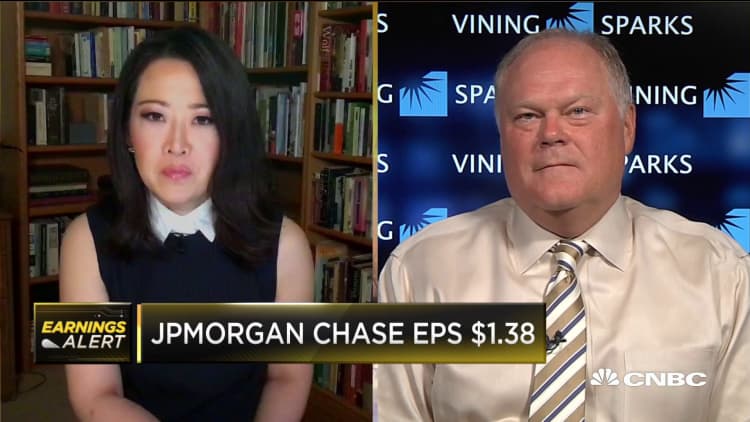
JPMorgan Chase on Tuesday reported second-quarter profit that beat analysts' expectations on record trading revenue bolstered by surging volatility and the Federal Reserve's unprecedented actions to prop up credit markets.
The bank posted earnings of $4.69 billion, or $1.38 a share, exceeding the $1.04 per share estimate of analysts surveyed by Refinitiv. Revenue of $33 billion exceeded the $30.3 billion estimate. Shares of the New York-based lender rose 0.6% after jumping as much as 4% in the premarket.
"Despite some recent positive macroeconomic data and significant, decisive government action, we still face much uncertainty regarding the future path of the economy," CEO Jamie Dimon said in the release. "However, we are prepared for all eventualities as our fortress balance sheet allows us to remain a port in the storm."
JPMorgan, the biggest U.S. bank by assets, is the first major lender to report earnings for the period that ended in June. The company is closely watched for clues on how the coronavirus pandemic is impacting banks' retail and institutional businesses. While the company set aside $8.9 billion for expected loan losses across the firm, crimping results in the lender's giant retail bank, better-than-expected revenue in its Wall Street operations helped offset some of that pain.
The bank's traders handily exceeded expectations that were already heightened for the quarter after managers said in late May that markets revenue was headed for a 50% increase. It jumped by 79% to a record $9.7 billion, fueled especially by strong fixed income trading.
Bond traders posted revenue of $7.3 billion, a 120% increase from a year earlier, crushing the $5.84 billion estimate of analysts surveyed by FactSet by almost $1.5 billion. Equities traders posted revenue of $2.4 billion, beating the $2.07 billion estimate.
The retail banking division, however, posted a $176 million loss, compared with a $4.2 billion profit a year earlier, driven by the addition of loan loss reserves.
The key question investors have is whether the second quarter will represent the nadir for bank profits this year: Big banks are expected to show the largest loan loss provision for any quarter since the Great Recession because of the pandemic, according to analyst Jason Goldberg of Barclays.
The fate of the industry is tied closely to the path of the coronavirus because the unemployment caused by states shutting down their economies impacts the abilities of customers to repay debts.
Dimon said in May that the odds were "pretty good" that the economy would rebound in the second half of the year, driven by the reopening. But that scenario could be threatened by the recent progression of the coronavirus, which has already forced some states to reverse course and shutter businesses again.
While bank stocks have rebounded from their March lows, they have underperformed the broader indexes, which have been buoyed by the roaring technology sector.
One factor keeping bank stocks down: Low interest rates have pressured net interest margin, a key measure of profitability in the banking sector. The industry's loan books have also begun to shrink, driven in part by lower credit card usage and the fear of rising defaults.


